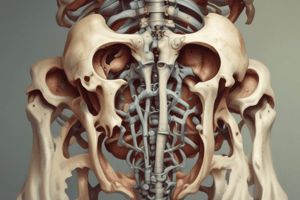Podcast
Questions and Answers
Which bones form each innominate bone of the pelvis?
Which bones form each innominate bone of the pelvis?
- Radius, ulna, and humerus
- Scapula, clavicle, and sternum
- Ilium, ischium, and pubis (correct)
- Femur, tibia, and fibula
Where do the innominate bones articulate with each other?
Where do the innominate bones articulate with each other?
- At the sacroiliac joints
- At the acetabulum
- At the femoral neck
- At the pubic symphysis (correct)
What is the shape of the femur designed for?
What is the shape of the femur designed for?
- Flexibility and range of motion
- Bearing body weight and transmitting ground reaction forces (correct)
- Supporting the upper body
- Protecting internal organs
Where is the acetabulum located?
Where is the acetabulum located?
What deepens the acetabulum?
What deepens the acetabulum?
Which ligament is located posteriorly to reinforce the hip joint capsule?
Which ligament is located posteriorly to reinforce the hip joint capsule?
What type of joint is the hip joint?
What type of joint is the hip joint?
What is the loose-packed position of the hip joint?
What is the loose-packed position of the hip joint?
What is the closed-packed position of the hip joint?
What is the closed-packed position of the hip joint?
What are the two planes commonly used to consider the femoral neck?
What are the two planes commonly used to consider the femoral neck?
Which factor enhances stability in the hip joint?
Which factor enhances stability in the hip joint?
Which factor compromises stability in the hip joint?
Which factor compromises stability in the hip joint?
Which injury is characterized by avascular necrosis of the proximal femoral epiphysis?
Which injury is characterized by avascular necrosis of the proximal femoral epiphysis?
Which injury commonly occurs as a result of a violent contraction or tractioning of the attaching muscle?
Which injury commonly occurs as a result of a violent contraction or tractioning of the attaching muscle?
Which injury is characterized by chronic irritation and excess secretion of synovial fluid within the hip joint capsule?
Which injury is characterized by chronic irritation and excess secretion of synovial fluid within the hip joint capsule?
Which injury is characterized by pain, swelling, and ecchymosis in the iliac crest?
Which injury is characterized by pain, swelling, and ecchymosis in the iliac crest?
Which injury is a common complication following hip dislocations, fractures, and chronic synovitis?
Which injury is a common complication following hip dislocations, fractures, and chronic synovitis?
Which injury results from overstretching or from a rapid, forceful contraction of the muscle?
Which injury results from overstretching or from a rapid, forceful contraction of the muscle?
Which factor is not listed as a stability issue in the hip joint?
Which factor is not listed as a stability issue in the hip joint?
Which injury is less common and is caused by excessive forcible exertion of the extremity that stretches or tears the surrounding ligaments?
Which injury is less common and is caused by excessive forcible exertion of the extremity that stretches or tears the surrounding ligaments?
Flashcards are hidden until you start studying
Study Notes
Innominate Bones
- Each innominate bone consists of three fused parts: ilium, ischium, and pubis.
- Innominate bones articulate with each other at the pubic symphysis and also connect to the sacrum at the sacroiliac joints.
Femur and Acetabulum
- The femur is designed for weight-bearing and mobility, offering a strong and stable structure.
- The acetabulum is located on the lateral aspect of the pelvis, where the femur articulates to form the hip joint.
- The depth of the acetabulum is enhanced by the acetabular labrum, which increases stability.
Hip Joint Structure
- The hip joint is a ball-and-socket synovial joint, allowing for multi-directional movement.
- Loose-packed position of the hip joint is when the hip is flexed at approximately 30 degrees with slight abduction and external rotation.
- Closed-packed position occurs when the hip is fully extended and internally rotated, providing maximum stability.
Femoral Neck Considerations
- Two commonly used planes for assessing the femoral neck are the frontal and transverse planes.
- Stability in the hip joint is enhanced by the strong ligaments and surrounding muscles.
Factors Compromising Stability
- A factor that compromises hip joint stability includes excessive mobility around the joint.
Hip Injuries
- Avascular necrosis of the proximal femoral epiphysis is known as Legg-Calvé-Perthes disease.
- Hip flexor strain commonly results from a violent contraction or traction of the attaching muscle.
- Hip bursitis is characterized by chronic irritation leading to excess synovial fluid secretion in the hip joint capsule.
- Contusions or pain at the iliac crest indicate an iliac crest contusion.
- Post-traumatic complications following hip dislocations include avascular necrosis and osteoarthritis.
- Muscle strains can occur due to overstretching or rapid, forceful contractions.
- A stability issue not commonly listed is the anatomical variance in hip morphology.
- A less common injury resulting from excessive force is a ligamentous tearing or sprain in and around the hip joint.
Studying That Suits You
Use AI to generate personalized quizzes and flashcards to suit your learning preferences.




